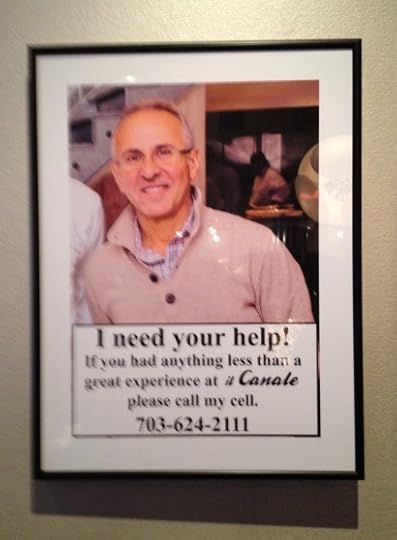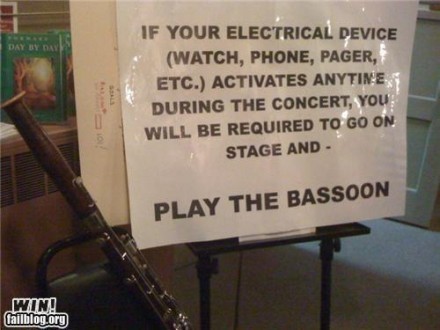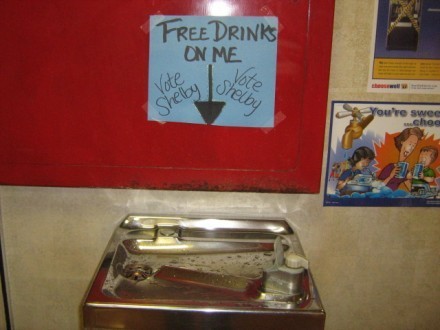Daniel H. Pink's Blog, page 12
November 21, 2011
Income inequality: Is what's good for the NBA good for your company?
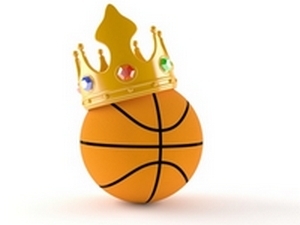 On the business pages, columnists are writing about income inequality. On the sports pages, they're discussing the labor economics of the National Basketball Association. Here at the Pink Blog, we can do both.
On the business pages, columnists are writing about income inequality. On the sports pages, they're discussing the labor economics of the National Basketball Association. Here at the Pink Blog, we can do both.
Take a look at this chart of the 50 highest paid NBA players. These guys make a lot of money – practically CEO money! — and they mostly deserve it. (Well, not you, Gilbert Arenas).
But not all players collect that kind of dough. For every Elton Brand getting $17 million per year, there's a teammate like Jodie Meeks earning $884,000.
Shouldn't that kind of inequality — Brand makes 19 times what Meeks does — breed resentment and hurt team performance?
Back in 1999, economist Craig Depken looked at wage disparity within major league baseball and found that, "high total salary levels improve team performance and great wage disparity reduces team performance." Teams that paid more equally performed better. Would the same be true of basketball?
Nir Halevy of Stanford and Adam Galinsky, Keith Murnighan, and Eileen Chou of Northwestern reasoned that hoops was different from baseball. Because basketball requires greater and more constant in-game coordination and cooperation, they suspected that team success in this sport depended on a more hierarchical system — one or two Kobes or Lebrons and a cast of supporting players.
To test their theory, they crunched pay and playing time data from 11 recent NBA seasons. It turned out that teams with "stars" – players who received mega-paychecks and were consistently in the starting line-up – performed better and showed more indicators of cooperation and coordination (e.g., assists) than more egalitarian teams.
In a press release, Galinsky explained why he thinks the star system works: "In a team environment where players are dependent on each other, they may see hierarchy as both legitimate and fair, which is likely to make the hierarchy function effectively."
There may be another factor at play here. Unlike salaries in most organizations, NBA salaries are highly publicized and publicly available. The transparency of the system means the star is as accountable to his teammates as they are to him and proportionally more responsible for the team's success.
All of which raises some questions. Are large companies more like the Miami Heat or the Miami Marlins? That is, do they work better as star-dominated hierarchies or clusters of independent performers? And depending on your answer, does that inevitably mean that either (a) executive pay should be more transparent or (b) corporate pay disparities should be less outrageous?
November 14, 2011
5 email newsletters worth reading
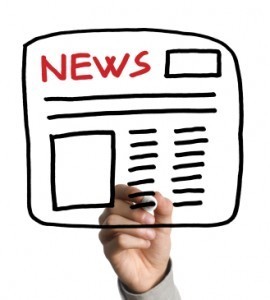 One reason I like writing email newsletters is that I also like reading them. Last month, a few folks asked me which e-newsletters I regularly read — not the ones I subscribe to, but those I actually read.
One reason I like writing email newsletters is that I also like reading them. Last month, a few folks asked me which e-newsletters I regularly read — not the ones I subscribe to, but those I actually read.
Here, in alphabetical order, are my top five:
1. ArtsJournal – A fascinating roundup of stories on media, publishing, visual art, music, and the world of ideas. Daily and weekly.
2. NBER Digest – Brief but comprehensive summaries of the most interesting and important new economics papers. Monthly.
3. SmartBrief on Workforce – For HR nerds only, this e-zine has lots of great links about talent, organizational behavior, and management. Daily.
4. Springwise – An amazing roundup of new business ideas and surprising business models from around the world. Daily and weekly.
5. Very Short List – A book, a film, a DVD, a TV show, an album that you probably haven't heard of and probably should. Daily.
Got e-newsletters that you enjoy? Let me know about them and I'll publish a list of reader picks.
BTW, if you'd subscribed to our own (irregular and irreverent) newsletter, you'd have received the above list a week ago.
November 7, 2011
Call my cell
On Saturday night, Mrs. PinkBlog and I — along with two-thirds of our progeny — decided to go out for pizza. We chose a place about three miles from our house called Il Canale, which a friend (an Italian journalist posted in the States) had raved about.
I wasn't sure what to expect. But moments after walking in, I saw this sign, featuring the smiling face of owner Giuseppe Farruggio:
As it turned out, the restaurant was outstanding and we had no need to call Signore Farruggio. But his offer left me wondering.
Why doesn't Jeff Smisek give out his phone number on those videos that United Airlines plays before each flight? Or Patrick Donahoe on a placard in every American post office? Or the manager of your local grocery store on its shopping carts? Or, uh, authors on their book jackets?
It's easy to proclaim, "I'm accountable." It's tougher to say, "Call my cell."
November 4, 2011
Ask Jim Collins anything you want
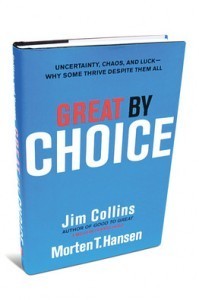 Our next guest on Office Hours will be Jim Collins, author of the legendary book Good to Great and co-author of the just released Great by Choice. (Buy it on BN.com, IndieBound, or Amazon.)
Our next guest on Office Hours will be Jim Collins, author of the legendary book Good to Great and co-author of the just released Great by Choice. (Buy it on BN.com, IndieBound, or Amazon.)
Join us Tuesday November 8 at 11am, EST, for what promises to be a terrific conversation.
What's Office Hours?
We call it "Car Talk . . . for the human engine." But you can call it that special hour once a month when a guest and I open up the phone lines and take your questions about business, work, and life in general. It's a new approach to radio and podcasting that is already lighting up the scoreboard on iTunes.
To participate in the next show, just dial in on 703.344.2171 at 11am, EST, on Tuesday November 8 — and enter this passcode: 203373#. You'll then be able to listen in and "raise your hand" to ask Jim any question that's on your mind or to get his advice on some business challenge you face.
For more info, or to receive an email reminder, go to the Office Hours page.
November 2, 2011
4 diverse emotionally intelligent signs
Each week PinkBlog readers send us lots of examples of emotionally intelligent signage they've spotted in their communities. Here are four recent submissions that caught our eye.
The talented Michael Bungay Stainer sends this sign, which does a nice job of eliciting empathy in the viewer:
[image error]
P.K. Ware offers a stern but attention-getting way to keep people quiet during concerts:
Jeremy Epstein provides a more poignant warning from the streets of New Delhi:
And Cody Toone, who teaches at Cardston Elementary School in Alberta, sends this campaign poster from a grade six student election. I'm not sure the sign quite fits the definition of emotionally intelligent signage, but I am sure that Shelby has a future in politics:
Got a sign of your own? Send it to us.
October 31, 2011
Jim Collins on 3 ways to avoid demotivating people at work
Jim Collins — the author of the legendary Good to Great and co-author of the new and equally compelling Great by Choice – has an insightful 3-minute Big Think video describing three ways organizations demotivate their employees.
– has an insightful 3-minute Big Think video describing three ways organizations demotivate their employees.
Watch it below or view it on Big Think. Then send a copy to your boss.
** BREAKING NEWS: Collins will be our special guest on the next episode of Office Hours. Mark your calendars for Tuesday November 8 at 11am Eastern. Call in details and passcode are here.
October 24, 2011
The power of an hourly beep
 Peter Bregman is a strategy consultant who advises some of North America's top CEO's and writes widely-read blog for the Harvard Business Review.
Peter Bregman is a strategy consultant who advises some of North America's top CEO's and writes widely-read blog for the Harvard Business Review.
Last month he published his second book, 18 Minutes: Find Your Focus, Master Distraction, and Get the Right Things Done, which is packed with smart, practical advice for boosting individual performance. (Buy it at Amazon, BN.com, Indie Bound, or 8CR.)
Because I thought PinkBlog readers would dig what he had to say, I asked him to share a tip from the book — something quick and actionable that could help us on a Monday morning.
Here's Peter:
I start every day with a plan. Each morning I look at my to do list and ask myself 'what will make this a successful day? Then I transfer the right tasks from my list onto my calendar and get to work.
But it's rare that I stick to every minute of my plan. Emails come in, phones ring, texts beep, and my own penchant for distraction sneaks up on me. It doesn't take me long to wander off from my schedule. And sometimes, like in a recent angry exchange with my phone company representative, I'll wander off from myself too.
It used to be that I'd end each day disappointed, wondering why it wasn't the success I had envisioned.
But that changed when I started setting hourly beeps.
Each hour when my watch, computer, or phone beeps, I stop whatever I'm doing, take a deep breath, and ask myself two questions:
1. Am I doing what I most need to be doing right now?
2. Am I being who I most want to be right now?
At first it seemed counterintuitive to interrupt myself each hour. Aren't interruptions precisely what we're trying to avoid? But these one-minute-an-hour interruptions are productive interruptions. They bring us back to doing what, and being who, will make this a successful day.
This isn't all about staying on plan. Sometimes the beep will ring and I'll realize that, while I've strayed from my calendar, whatever it is I'm working on is what I most need to be doing. In those situations I simply shift items on my calendar so my most important priorities still get done and I make intentional choices about what I will leave undone.
For me, a once-an-hour reminder, one deep breath, and a couple of questions, has made the difference between ending my day frustrated and ending it fulfilled.
October 20, 2011
Take a trip to the Idea Store
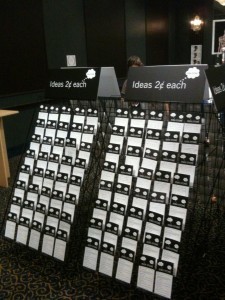 A few weeks ago, Mrs. PinkBlog and I hopped into the family Toyota and drove to southwest Washington, DC, for the (e)merge art fair – a sprawling assemblage of creations from up-and-coming painters, sculptors, photographers, and performers. We saw some interesting stuff (and a lot of total dreck), but one of the most arresting pieces was the kind of art you can't exactly hang on your rec room wall.
A few weeks ago, Mrs. PinkBlog and I hopped into the family Toyota and drove to southwest Washington, DC, for the (e)merge art fair – a sprawling assemblage of creations from up-and-coming painters, sculptors, photographers, and performers. We saw some interesting stuff (and a lot of total dreck), but one of the most arresting pieces was the kind of art you can't exactly hang on your rec room wall.
On the first floor of the fair, Athena Robles and Anna Stein, two Brooklyn artists, set up an installation called The Idea Store.
The premise was simple. People who visited a makeshift storefront – think Lucy Van Pelt's psychiatrist office – could fill out a card offering an idea and get paid a penny for it. Robles and Stein then placed the card on the kind of rack you might find at a Hallmark store. Then other visitors could select an idea from the rack and purchase it for two cents.
Some of the ideas on offer were silly. Others were thumbsuckingly obscure. But many were sublime.
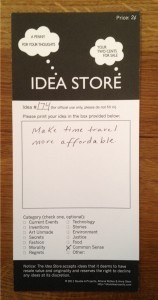 Over to the right is an idea that I bought with two pennies I dug out of my pocket. (You might need to click the photo to actually read the card.)
Over to the right is an idea that I bought with two pennies I dug out of my pocket. (You might need to click the photo to actually read the card.)
Yet the best idea of all may have been the notion of the store itself. It evoked all sorts of associations – the marketplace of ideas, contributing your two cents worth, and so on. And it raised lots of interesting questions: Why is one idea "worth" more than another? Why are some ideas easier to "sell"? Is it possible really to "own" an idea? And, of course, why does this topic make me use so many quotation marks?
Although The Idea Store was formulated as a piece of art, I think that with a few tweaks it could work well in other settings for other purposes.
Maybe something like an Idea Store could be a feature of your organization's next offsite or your association's next conference. Maybe you could set one up in the student union or school cafeteria. Maybe having one in your office lobby could generate suggestions and trigger conversations.
Give it some thought. This might be an Idea Store whose time has come.
October 18, 2011
How to find great talent: 4 questions for Bloomberg View's George Anders
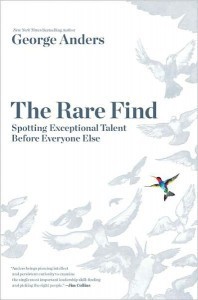 Here's a question that bedevils everyone from Fortune 500 boards seeking a replacement CEO to school principals hiring a new algebra teacher, from families looking for a great electrician to baseball teams searching for a better shortstop:
Here's a question that bedevils everyone from Fortune 500 boards seeking a replacement CEO to school principals hiring a new algebra teacher, from families looking for a great electrician to baseball teams searching for a better shortstop:
How do you find extraordinary, game-changing talent?
George Anders is a top-shelf business journalist, a veteran of the Wall Street Journal, Fast Company, and now Bloomberg View. For the last couple of years, he's tried to answer that question by hanging out with the best talent spotters in the world – the U.S. Army's Special Forces, a squadron of basketball scouts, the folks at Facebook, and many more.
The result is The Rare Find: Spotting Exceptional Talent Before Everyone Else, which hits stores today. (Buy it from Indie Bound, BN.com, Amazon.com or 8CR.) I had a chance to read the galleys several months ago – and I enjoyed it so much I asked George if he'd do a short interview explaining some of the core concepts for PinkBlog readers.
or 8CR.) I had a chance to read the galleys several months ago – and I enjoyed it so much I asked George if he'd do a short interview explaining some of the core concepts for PinkBlog readers.
***
You looked at talent both widely and deeply. What's the big insight you had after completing this book that you didn't have when you began it?
Everybody should be searching for resilience, and hardly anyone does. Being able to bounce back from adversity is crucial in just about every field I examined. You need resilience to be a great CEO, a great teacher, soldier, investor, etc., etc. But when we hire, we're taught to regard setbacks — regardless of what came next — as flaws in a candidate. So when we prepare our own resumes, we hide our stumbles. That's wrong! We should cherish people who have extricated themselves from trouble in the past.
I was especially intrigued by your idea of the "jagged resume" in part because I realized that I myself sorta had one of these way back when. Tell us what you mean by that term and why it matters.
Steve Jobs is a perfect example. Both in the 1970s and the 1990s, his life was a wild blend of great strengths and apparent failures. He had this awesome imagination, persuasiveness, ambition and design aesthetic. But he was a college dropout who later got forced out of one company (Apple) and couldn't make a success of another (NeXT.) You could come up with lots of reasons why his resume was too erratic — too jagged — to make him a good bet. But to appreciate someone like that, you need to see why his strengths matter so much, and why his apparent flaws aren't important.
You also write about "talent that whispers" — and why it's sometimes undervalued. Give us an example and explain why we should notice this expression of ability.
Look at the amateur baseball draft, where some teams stop picking after 30 rounds because they assume all the good players have already been grabbed. Every year or two, a future All-Star sits unclaimed. Mike Piazza, the great catcher, was a 62nd round pick. Weird but true. Especially when you're dealing with young, unproven people, some candidates show just a glimmer of promise. Their talent whispers. Don't scoff at them. Look to open the door, just a crack, so that when long shots come of age, they're more likely to be working for you than for the competition.
Let's say a PinkBlog reader wants to be a "rare find" him or herself. What are some specific things he or she should be doing to stand out from the crowd?
Find the frontier. If you want to be extraordinary, restlessness is a virtue. It's also a great traveling companion for resilience; if you can combine the two of them, your chances of finding society's greatest opportunities in any particular decade are huge. Hang out with people just as driven and passionate as you. The great hotbeds of talent are self-sustaining because competitive internal friendships guide rapid progress. When in doubt, come back to autonomy, mastery and purpose. Those are keepers!
October 11, 2011
How do you sign an e-book?
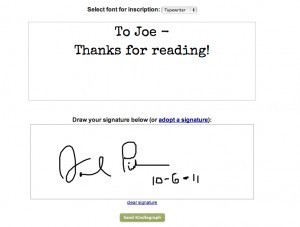 That's a question that writers, and others with plenty of time on their hands, have been pondering since the intelligentsia realized that electronic books are a force rather than a fad.
That's a question that writers, and others with plenty of time on their hands, have been pondering since the intelligentsia realized that electronic books are a force rather than a fad.
It's easy to ink a signature across the title page of a paper book. It's cool, too. (As it happens, I collect autographed books inscribed to the three PinkBlog children.)
But what happens when the book you own consists of atoms behind a screen instead of bits in your hand?
Evan Jacobs has an answer. He calls it Kindlegraph.
You sign in — for free — with your Twitter account. You look up your favorite book or author. Then you click a button that says "Request Kindlegraph." That sends a note to the author, who then uses her finger and her computer trackpad to "sign" your ebook and zap it to your Kindle. See above for an e-book that I signed a few days ago.
It's not a perfect solution, of course. But it does represent a nice first step to connect readers and writers in the digital age. So if you're an ebook devotee, give it a try. I'm getting much better at signing with my index finger. (The Nook Color apparently has an autographing function, too. If you're a Nook user, email and tell me how it works.)
Also — and this is important — if you prefer the kind of books with paper, fear not. If you'd like a signed Drive bookplate, just complete this super-short form and we'll snail mail you one for free. It won't arrive instantly and magically. But it will bear a trace of the unbeatable smell of a Sharpie.

